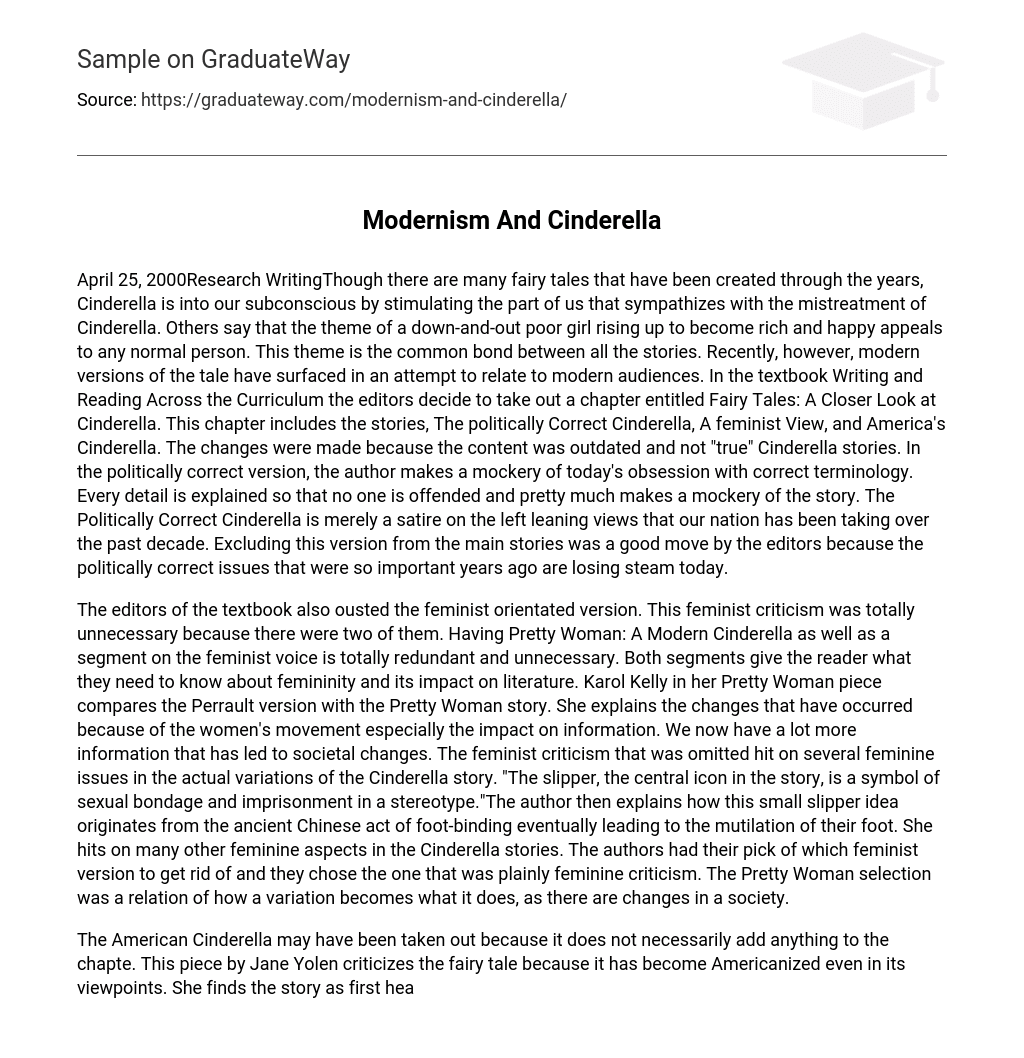Even though there have been numerous fairy tales developed over time, Cinderella remains ingrained in our collective consciousness. It taps into our empathy for Cinderella’s mistreatment. Some argue that the universal appeal lies in the story of a disadvantaged girl defying odds to attain wealth and happiness. This theme unites all versions of the tale. However, modern adaptations have emerged in order to connect with contemporary audiences.
The editors of the textbook “Writing and Reading Across the Curriculum” have removed a chapter called “Fairy Tales: A Closer Look at Cinderella.” This chapter consists of stories such as “The Politically Correct Cinderella,” “A Feminist View,” and “America’s Cinderella.” The reason for removing this chapter is that its content is outdated and does not align with the true essence of Cinderella stories. In the politically correct version, the author satirizes society’s current preoccupation with precise terminology. Every aspect of the story is explained to avoid offending anyone, effectively mocking the original narrative.
The exclusion of The Politically Correct Cinderella from the main stories was a wise decision by the editors. It serves as a satire on the left-leaning views that our nation has adopted in recent years, reflecting the declining importance of politically correct issues in today’s society.
The editors of the textbook removed the feminist-oriented version, which was deemed unnecessary since there were already two segments on feminism. Including both Pretty Woman: A Modern Cinderella and a segment on the feminist voice is redundant and not needed. Both segments cover the essential information about femininity and its role in literature.
Karol Kelly, in her analysis of “Pretty Woman,” juxtaposes the version by Perrault with the modern-day rendition. Kelly explores the alterations that have transpired due to the women’s movement, particularly its influence on the availability and dissemination of information. As a result, our society has experienced significant transformations facilitated by the abundance of knowledge.
The various versions of the Cinderella story were subject to feminist criticism, highlighting several feminine issues. The critique focused on the slipper, a central symbol in the story, which was seen as representing sexual bondage and the imprisonment of women in stereotypes. The author specifically noted that the notion of the slipper originated from the ancient Chinese practice of foot-binding, which ultimately resulted in the mutilation of women’s feet. Along with this, other feminine aspects in Cinderella stories were also addressed. The authors had the option to eliminate any feminist version, but they specifically chose one that contained direct criticism of female stereotypes. Meanwhile, the selection of Pretty Woman portrayed how variations can transform based on changes within society.
The American Cinderella has been omitted because it does not contribute significantly to the chapter. Jane Yolen’s critique of the fairy tale focuses on its Americanization, both in terms of its origin as heard by settlers and its later retelling in books by settled folklorists. Yolen traces the changes that have transformed it into our version of Cinderella. Despite this, she disagrees with its perspective and argues that “mass-market American Cinderellas have presented the majority of American children with the wrong dream.” The editors of the text removed unnecessary stories that would have confused readers due to their extreme viewpoints.
The attempt at comedy in politically correct Cinderella is not really comedy but more irritating. Everything is explained and made to be inoffensive, which has become tiresome. Removing it from the book was a wise decision. The omission of feminist criticism is due to limited space, and America’s Cinderella, like the others, does not contribute to the chapter.
American criticism does not provide any new knowledge to American students. The authors made the right decision by eliminating the chapter, enabling the reader to gain a deeper understanding of the true Cinderella.





